Nigeria’s economy recorded better than expected private sector credit growth in the third quarter of this year, with more borrowers funnelling the proceeds towards CAPEX-related activities – despite next year’s federal election looming. Bonds & Loans spoke with Jan Friederich, a senior director at Fitch Ratings about lingering risks in the country. Excerpts
:
What is the economic outlook for Nigeria over the near to medium term? What are some of the bright spots and what are the areas giving you concern – and key drivers for these?
Nigeria’s economy is recovering gradually and we expect growth of 2.4% in 2018 rising to 3.3% in 2020. Clearly a positive force is the rising oil price this year and the improvement in the availability of foreign exchange. Security challenges to oil production remain a risk, and uncertainty about the election may weigh on activity in the near term.
What is your baseline expectation for the global economic environment?
This year promises to be a good vintage for global GDP growth, with ongoing tightening of labour markets across the largest advanced economies underpinning consumer spending. Helped by pro-cyclical fiscal stimulus, unemployment in the US is likely to hit a 66-year low. But, it is also likely to be too good to last. Global quantitative tightening will start in earnest next year and an escalation of trade tensions has the potential to knock off 0.4 percentage points of world GDP growth.
How do you see the current account balance being influenced by recent shifts in Nigeria’s markets?
Oil prices are key for Nigeria’s current account balance. So, the current upswing in oil prices should help bring about a current account surplus of 2.8% of GDP in 2018, although the continued easing of FX constraints and recovering economic growth should reduce the surplus in the following two years by allowing for higher levels of imports.
Are there any policy areas, macro, fiscal or monetary, that you feel need more focus from policymakers?
Nigeria stands out for its very low level of government revenues, which we estimate at around 6% of GDP this year. This means that relative to revenue, the levels of interest expenditure and of debt are very high although they are only moderate relative to GDP. We are still monitoring the evolution of the exchange rate regime quite closely. The current regime, combined with higher oil prices and oil production, has increased FX availability, but the multiple rate system may still be weighing on growth and likely complicates monetary policy making.
What do you see as some of the more significant growth drivers in Nigeria currently?
The increased availability of foreign exchange and the government’s greater investment in infrastructure are among the factors supporting growth. From a longer-term perspective, Nigeria has the potential for a strong private sector supported by a large population and strong demographic growth, but the level of informality is acting as a brake on growth.
What is your take on the inflation outlook? Do you see any risks on the horizon?
The main risk to inflation is that the recent sharp fall in inflation will stop early. Monetary policy signalling is not clear and so it is uncertain whether conditions are right for inflation to return to the Central Bank of Nigeria’s target range.
Are there any major catalysts or contingencies on the horizon which could significantly alter the outlook of Nigeria?
Among the high-impact but low-probability risks are disruptions to oil production or disorderly run of next year’s election.
Is debt accumulation in Nigeria currently keeping pace with employment and economic growth?
General government debt stands at 294% of revenue, which is relatively high. Just counting the federal government, revenue the ratio would be even higher.
This means that although the level of debt to GDP is low (24%), the pace of debt accumulation, supported by a greater focus on improving infrastructure, is an issue Fitch is monitoring.









